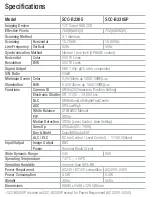
JR_EYE‐02.ENG.MAN.MANUAL.10.DOCX
‐ 19 ‐
8.3
S
AFETY
I
NSTRUCTIONS
Read these guidelines. Not following them may be dangerous and/or illegal.
You alone are responsible for how you use your device and any consequences of its use. Do not switch the device on
wherever the use of a wireless device is prohibited or when it may cause interference or danger.
Small Children
Do not leave your device and its accessories within the reach of small children or allow them to play with it. They could hurt
themselves or others, or could accidentally damage the device. Your device contains small parts with sharp edges that may cause
an injury or which could become detached and create a choking hazard.
Some countries may regulate the security camera usage by special laws. Please study the possible law restrictions for certain
country before installing the camera.
Interference
Your device contains a transmitter and a receiver. When it is ON, it receives and transmits RF energy. Care must be taken when
using the device in close proximity to personal medical devices, such as pacemakers and hearing aids. All wireless devices are
susceptible to interference, which could affect performance.
We (JABLOCOM) are not responsible for any radio or TV interference caused by unauthorized modifications to this equipment. Such
modifications could void the user’s authority to operate the equipment.
Your device is designed not to exceed the limits for exposure to radio waves recommended by international guidelines. These
guidelines were developed by the independent scientific organization ICNIRP and include safety margins designed to assure the
protection of all persons, regardless their age and health.
This equipment has been tested and found to comply with the limits for a Class B digital device, pursuant to part 15 of
the FCC Rules. These limits are designed to provide reasonable protection against harmful interference in a residential
installation
.
This equipment generates, uses and can radiate radio frequency energy, and if not installed and used in accordance with the
instructions, may cause harmful interference to radio communications. However, there is no guarantee that interference will not
occur in a particular installation. If this equipment does cause harmful interference to radio or television reception, which can be
determined by turning the equipment off and on, the user is encouraged to try to correct the interference by one or more of the
following measures:
-
Reorient or relocate the receiving antenna.
-
Increase the separation between the equipment and receiver.
-
Connect the equipment into an outlet on a circuit different from that to which the receiver is connected.
-
Consult the dealer or an experienced radio/TV technician for help.
Pacemakers
Pacemaker manufacturers recommend that a minimum separation of 15 cm to be maintained between a mobile device and a
pacemaker to avoid potential interference with the pacemaker. To achieve this use the device body in distance more than 15cm
from your pacemaker.
Hearing Aids
People with hearing aids or other cochlear implants may experience interfering noises when using wireless devices or when one is
nearby. The level of interference will depend on the type of hearing device and the distance from the interference source,
increasing the separation between them may reduce the interference. You may also consult your hearing aid manufacturer to
discuss alternatives.
Medical devices
Please consult your doctor and the device manufacturer to determine if operation of your device may interfere with the operation
of your medical device.
Hospitals
The device isn’t designed to be used in hospitals, clinics or health care facilities without a consultancy with the staff or medical
equipment producers. This request is designed to prevent possible interference with sensitive medical equipment
Wireless devices
can cause interference in aircraft.
Explosive environments
In locations with potentially explosive atmospheres, obey all posted signs to turn off wireless devices such as your device or other
radio equipment.
Areas with potentially explosive atmospheres include fuelling areas, below decks on boats, fuel or chemical transfer or storage
facilities, areas where the air contains chemicals or particles, such as grain, dust, or metal powders.
Blasting Caps and Areas
The device isn’t recommended to be used in a blasting area or in areas posted turn off “two‐way radios” or “electronic devices” to
Содержание EYE-02
Страница 1: ...GSM Security Camera EYE 02 ...




































